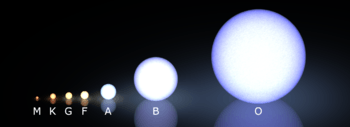37 Geminorum
| Observation data Epoch J2000 Equinox J2000 | |
|---|---|
| Constellation | Gemini |
| Right ascension | 06h 55m 18.66757s[1] |
| Declination | +25° 22′ 32.5153 ″[1] |
| Apparent magnitude (V) | 5.73[2] |
| Characteristics | |
| Spectral type | G0 V[3] |
| U−B color index | +0.01[2] |
| B−V color index | 0.599[4] |
| Astrometry | |
| Radial velocity (Rv) | -11.3[5] km/s |
| Proper motion (μ) | RA: -35.91[1] mas/yr Dec.: +25.65[1] mas/yr |
| Parallax (π) | 58.00 ± 0.40[1] mas |
| Distance | 56.2 ± 0.4 ly (17.2 ± 0.1 pc) |
| Details | |
| Luminosity | 1.22[6] L☉ |
| Surface gravity (log g) | 4.29[3] cgs |
| Temperature | 5,874[7] K |
| Metallicity [Fe/H] | -0.25[7] dex |
| Rotational velocity (v sin i) | 1.89[4] km/s |
| Age | 5.49[8] Gyr |
| Other designations | |
37 Geminorum is a star located at the northwest part of the northern zodiac constellation of Gemini. Its distance from the Sun is about 56.2 light years. It is a solitary, G-type main sequence star with a stellar classification of G0 V. No extrasolar planets have yet been discovered around it.
37 Geminorum has many physical properties in common with the Sun and is one of the nearest solar analogs. Due to this fact some scientists believe that the prospects for life in its vicinity are good. In September 2003, 37 Geminorum was identified by astrobiologist Margaret Turnbull from the University of Arizona in Tucson as one of the most promising nearby candidates for hosting life, based on her analysis of the HabCat list of stars.
There was a METI message sent to 37 Geminorum. It was transmitted from Eurasia's largest radar, 70-meter Yevpatoria Planetary Radar. The message was named the Teen Age Message, it was sent on September 3, 2001, and it will arrive at 37 Geminorum in December 2057.[10]
Sun comparison
This chart compares the sun to 37 Geminorum.
| Identifier | J2000 Coordinates | Distance (ly) |
Stellar Class |
Temperature (K) |
Metallicity (dex) |
Age (Gyr) |
Notes | |
|---|---|---|---|---|---|---|---|---|
| Right ascension | Declination | |||||||
| Sun | — | — | 0.00 | G2V | 5,778 | +0.00 | 4.6 | [11] |
| 37 Geminorum [12] | 06h 55m 18.66s | +25° 22′ 32.51″ | 56.2 | G0 V | 5,874 | +0.023 | 5.49 | |
To date no solar twin with an exact match as that of the Sun has been found, however, there are some stars that come very close to being identical to that of the Sun, and are such considered solar twins by the majority of the public. An exact solar twin would be a G2V star with a 5,778K temperature, be 4.6 billion years old, with the correct metallicity and a 0.1% solar luminosity variation.[13] Stars with an age of 4.6 billion years are at the most stable state. Proper metallicity and size are also very important to low luminosity variation.[14][15][16]

See also
References
- 1 2 3 4 5 van Leeuwen, F. (2007), "Validation of the new Hipparcos reduction", Astronomy and Astrophysics, 474 (2): 653–664, arXiv:0708.1752
 , Bibcode:2007A&A...474..653V, doi:10.1051/0004-6361:20078357.
, Bibcode:2007A&A...474..653V, doi:10.1051/0004-6361:20078357. - 1 2 Mermilliod, J.-C. (1986), "Compilation of Eggen's UBV data, transformed to UBV (unpublished)", Catalogue of Eggen's UBV data, SIMBAD, Bibcode:1986EgUBV........0M.
- 1 2 Gray, R.O.; et al. (July 2006), "Contributions to the Nearby Stars (NStars) Project: spectroscopy of stars earlier than M0 within 40 pc-The Southern Sample", The Astronomical Journal, 132 (1): 161–170, arXiv:astro-ph/0603770
 , Bibcode:2006AJ....132..161G, doi:10.1086/504637.
, Bibcode:2006AJ....132..161G, doi:10.1086/504637. - 1 2 Martínez-Arnáiz, R.; et al. (September 2010), "Chromospheric activity and rotation of FGK stars in the solar vicinity. An estimation of the radial velocity jitter", Astronomy and Astrophysics, 520: A79, arXiv:1002.4391
 , Bibcode:2010A&A...520A..79M, doi:10.1051/0004-6361/200913725.
, Bibcode:2010A&A...520A..79M, doi:10.1051/0004-6361/200913725. - ↑ Wilson, R. E. (1953), General Catalogue of Stellar Radial Velocities, Carnegie Institute of Washington D.C., Bibcode:1953GCRV..C......0W.
- ↑ McDonald, I.; et al. (2012), "Fundamental Parameters and Infrared Excesses of Hipparcos Stars", Monthly Notices of the Royal Astronomical Society, 427 (1): 343–57, arXiv:1208.2037
 , Bibcode:2012MNRAS.427..343M, doi:10.1111/j.1365-2966.2012.21873.x.
, Bibcode:2012MNRAS.427..343M, doi:10.1111/j.1365-2966.2012.21873.x. - 1 2 Holmberg, J.; et al. (2009), "The Geneva-Copenhagen survey of the solar neighbourhood. III. Improved distances, ages, and kinematics", Astronomy and Astrophysics, 501 (3): 941–947, arXiv:0811.3982
 , Bibcode:2009A&A...501..941H, doi:10.1051/0004-6361/200811191. See Vizier catalogue V/130.
, Bibcode:2009A&A...501..941H, doi:10.1051/0004-6361/200811191. See Vizier catalogue V/130. - ↑ Vican, Laura (June 2012), "Age Determination for 346 Nearby Stars in the Herschel DEBRIS Survey", The Astronomical Journal, 143 (6): 135, arXiv:1203.1966
 , Bibcode:2012AJ....143..135V, doi:10.1088/0004-6256/143/6/135.
, Bibcode:2012AJ....143..135V, doi:10.1088/0004-6256/143/6/135. - ↑ "37 Gem -- Star", SIMBAD Astronomical Database, Centre de Données astronomiques de Strasbourg, retrieved 2016-09-12.
- ↑ http://www.cplire.ru/rus/ra&sr/VAK-2004.html (Russian)
- ↑ Williams, D.R. (2004). "Sun Fact Sheet". NASA. Retrieved 2009-06-23.
- ↑ 37 Geminorum at SIMBAD - Ids - Bibliography - Image.
- ↑ NASA, Science News, Solar Variability and Terrestrial Climate, Jan. 8, 2013
- ↑ University of Nebraska-Lincoln astronomy education group, Stellar Luminosity Calculator
- ↑ National Center for Atmospheric Research, The Effects of Solar Variability on Earth's Climate, 2012 Report
- ↑ Most of Earth’s twins aren’t identical, or even close!, by Ethan on June 5, 2013
External links
- "37 Geminorum". SolStation. Archived from the original on 10 December 2005. Retrieved 2005-12-12.
- Design studio «Geminorum» in St.Petersburg, Russia